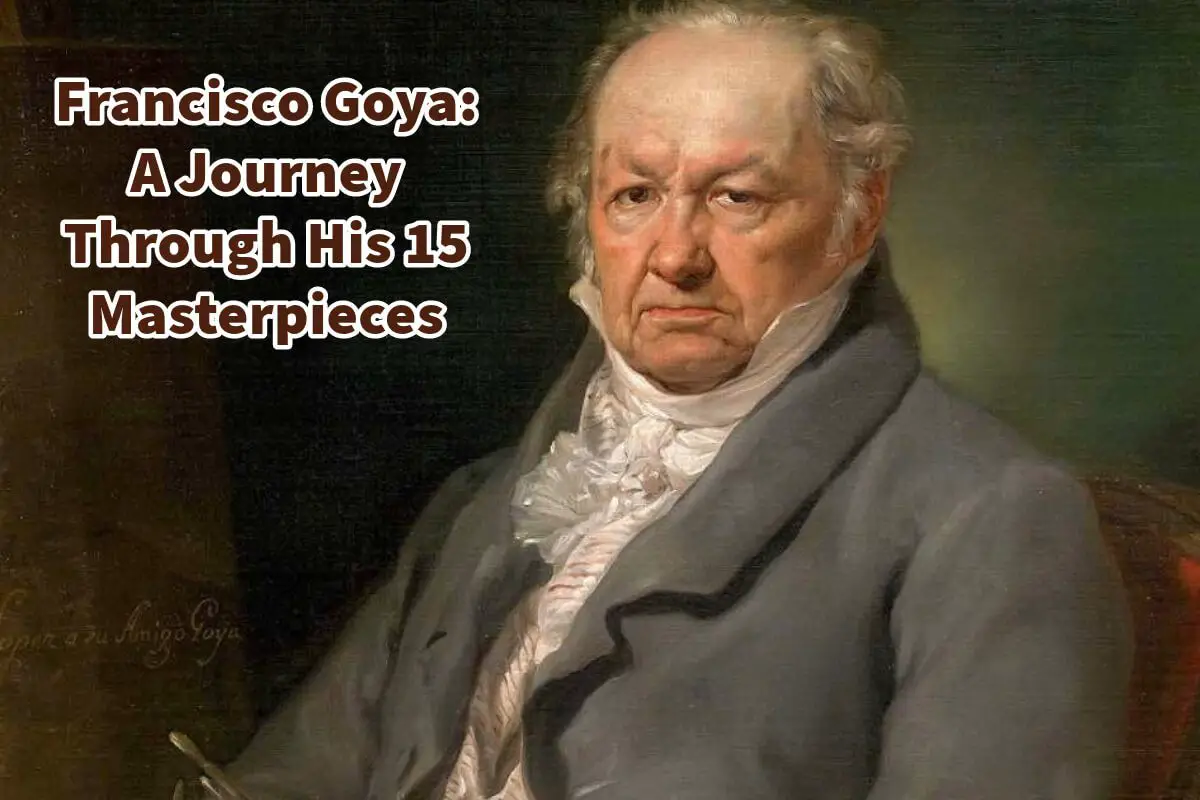Francisco Goya, frequently hailed as the bridge between the Old Masters and modern art, is a monumental presence in art history. He is considered one of the greatest artists to have ever lived.
Beyond his remarkable technical finesse, Goya had an uncanny ability to delve into and depict his time’s passionate tumult and political upheavals. His art provides a window into the raw spectrum of human emotions, ranging from sheer delight to profound dread. Let’s navigate through 15 of his most defining masterpieces.
Table of Contents
- Francisco Goya: A Journey Through His 15 Masterpieces
- The Third of May 1808 (1814)
- Saturn Devouring His Son (1819-1823)
- La Maja Desnuda (1797-1800)
- Witches’ Sabbath (The Great He-Goat) (1789)
- The Sleep of Reason Produces Monsters (1799)
- The Family of Charles IV (1800)
- The Clothed Maja (La Maja Vestida) (1800-1805)
- Duel with Cudgels (1819-1823)
- Portrait of the Duchess of Alba (1797)
- Dog Half-Submerged (1819-1823)
- Charles III in Hunting Dress (1786-1788)
- The Executions on Príncipe Pío (1814)
- The Colossus (1808-1812)
- The Inquisition Tribunal (1812-1819)
- Self-portrait in the Workshop (1790-1795)
- Francisco Goya: Spain’s Artistic Visionary
- Frequently Asked Questions
- Related Questions
Francisco Goya: A Journey Through His 15 Masterpieces
Francisco Goya, often called the last of the Old Masters and the first of the Moderns, is undoubtedly one of the most influential figures in art history.
His prowess was not just in his technical skills but in his ability to capture his era’s emotional and political turmoil. Through his works, we witness the haunting depths of human experience, from joy to horror.
Let’s embark on a journey through 15 of his most iconic paintings:
The Third of May 1808 (1814)
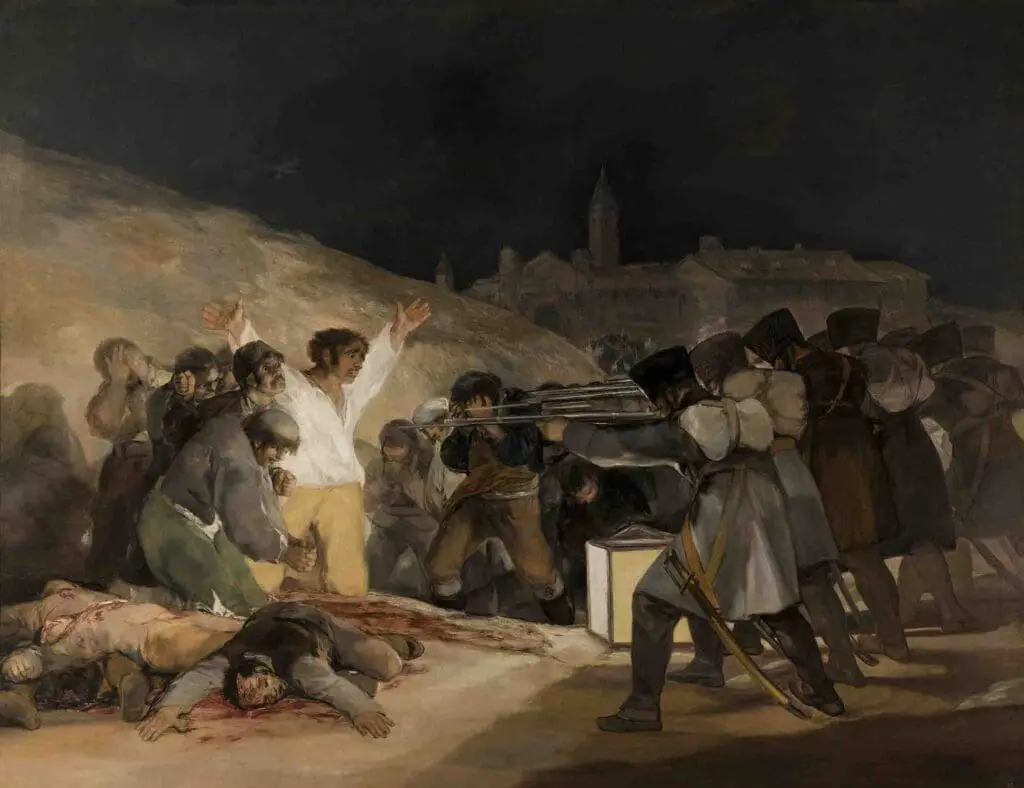
A chilling portrayal of the Spanish resistance to Napoleon’s armies, this piece showcases the horrors of war, with innocent civilians facing a firing squad. It’s raw emotion and political statement have made it one of Goya’s most celebrated works.
Saturn Devouring His Son (1819-1823)
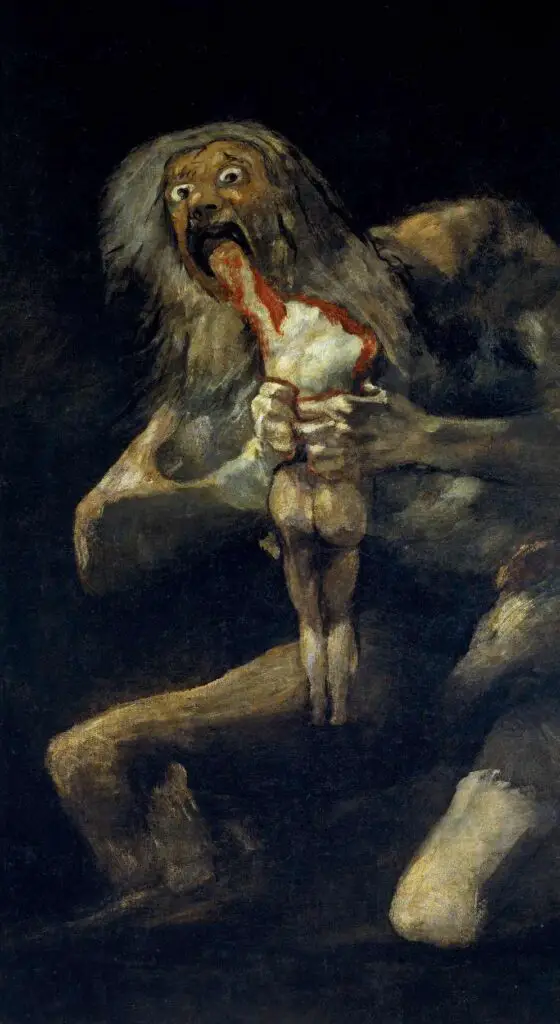
Part of his Black Paintings, this macabre depiction of the mythical figure consuming his child underscores themes of violence, fear, and the cyclical nature of time.
La Maja Desnuda (1797-1800)
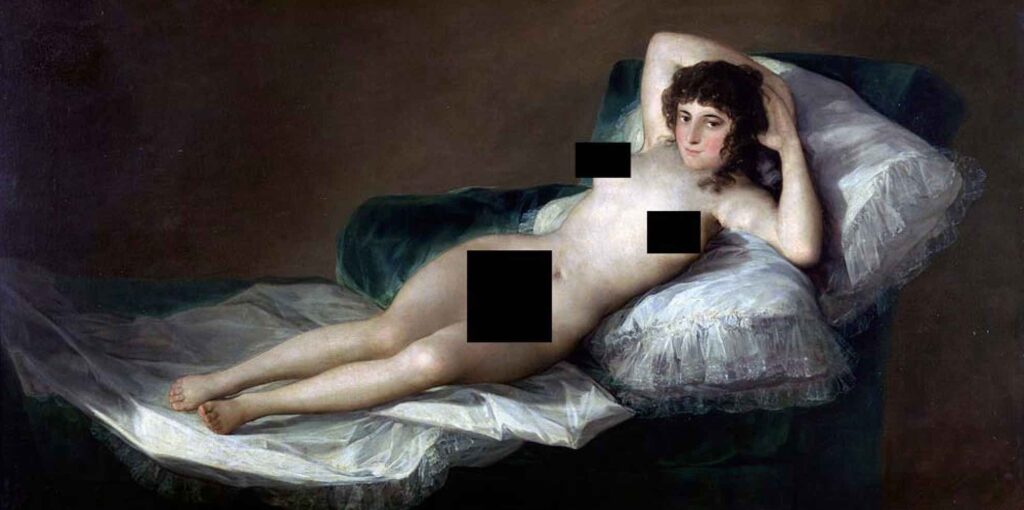
This sensuous portrait was revolutionary for its unabashed portrayal of a nude woman with no mythological context or pretense.
Witches’ Sabbath (The Great He-Goat) (1789)

This eerie piece represents the ignorance and superstition that Goya criticized in Spanish society.
The Sleep of Reason Produces Monsters (1799)
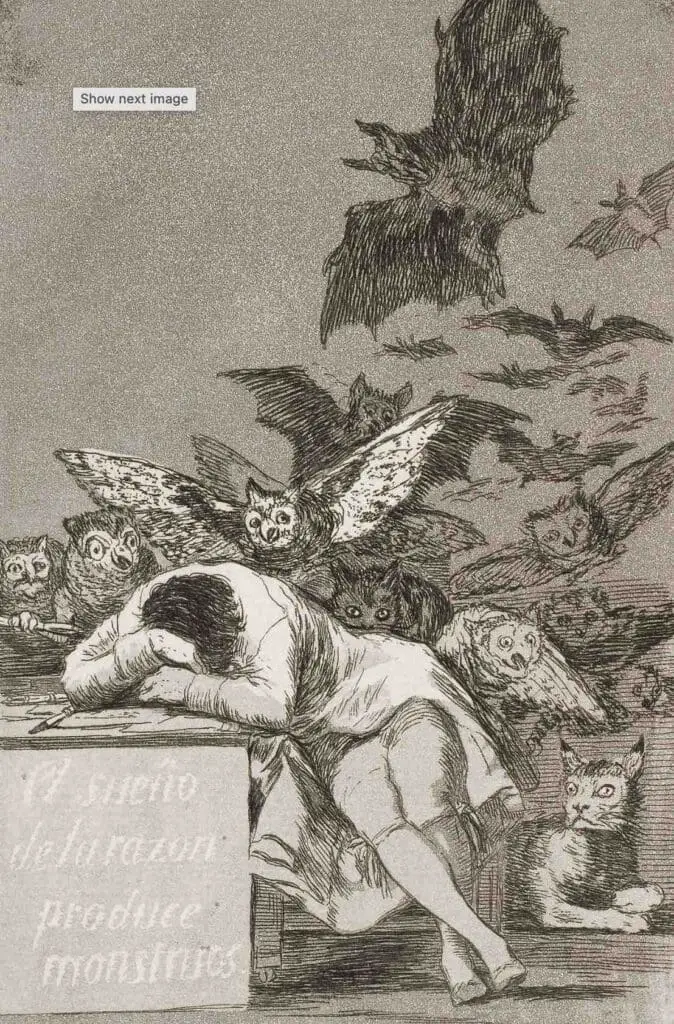
This artwork from his “Los Caprichos” series reveals Goya’s anxiety about his time’s prevailing ignorance and irrationality.
The Family of Charles IV (1800)
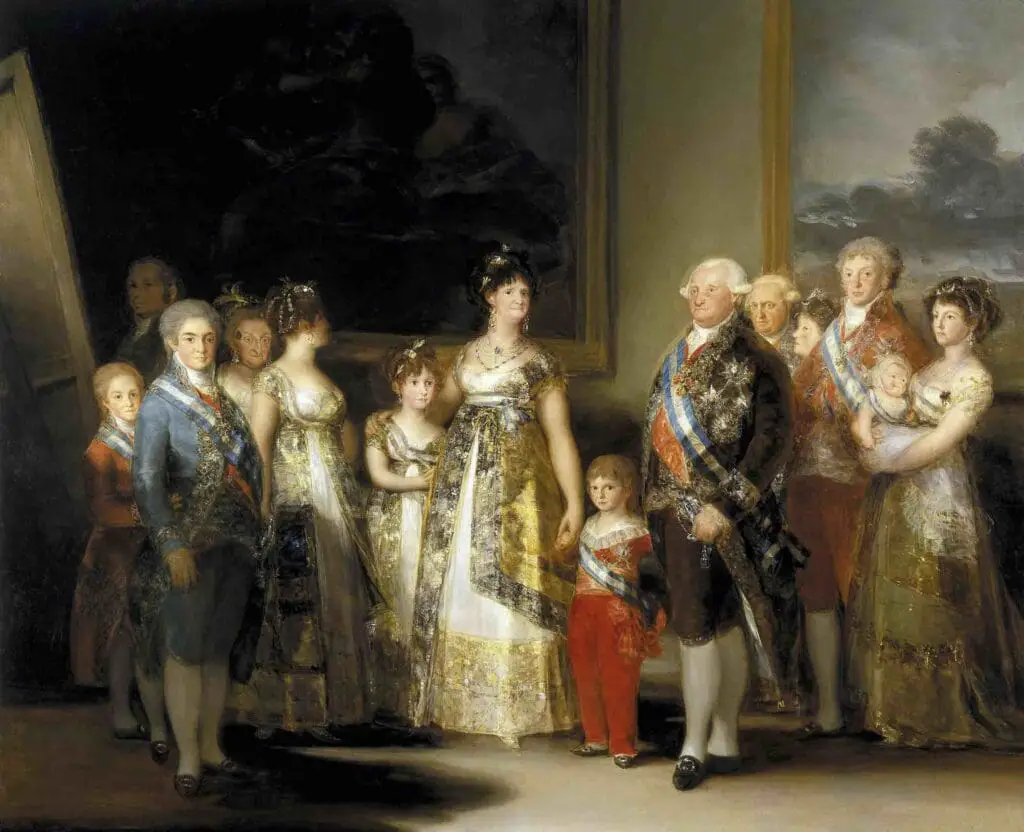
A royal portrait, this piece is noted for its candid representation of the royal family, with Goya himself appearing in the background.
The Clothed Maja (La Maja Vestida) (1800-1805)
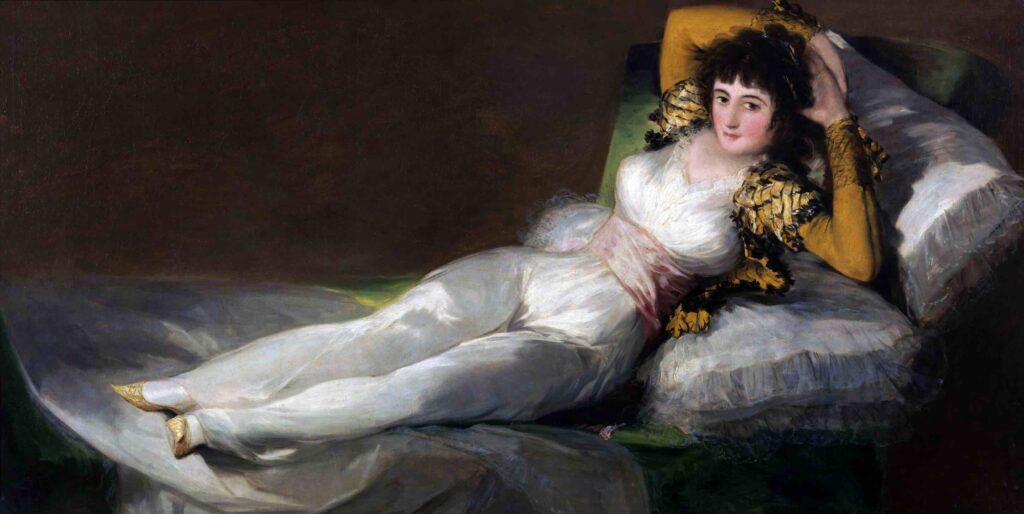
A clothed version of “La Maja Desnuda,” this painting showcases Goya’s impeccable technique and attention to detail.
Duel with Cudgels (1819-1823)
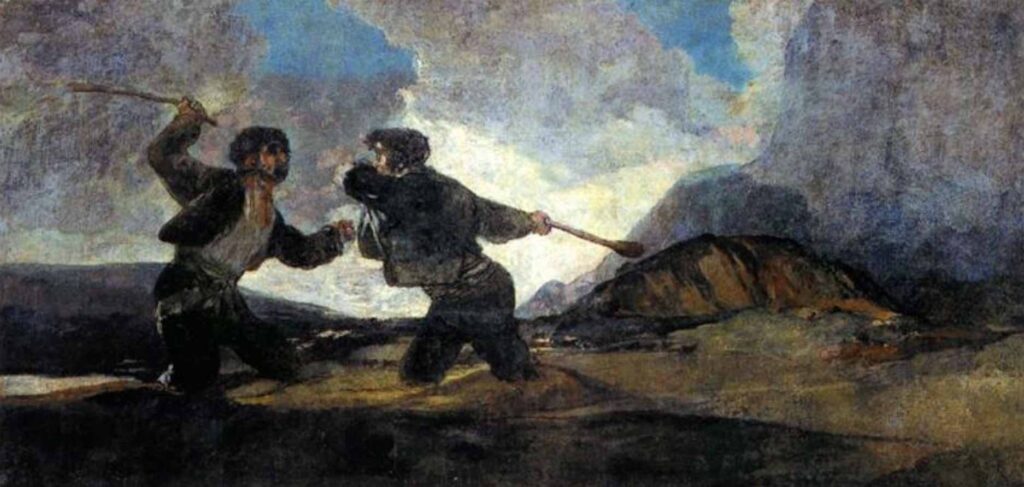
Another, his Black Paintings, depicts two men in a futile battle, symbolizing his era’s senseless violence and conflicts.
Portrait of the Duchess of Alba (1797)

A testament to Goya’s portrait skills, this artwork captures the pride, beauty, and spirit of one of Spain’s most powerful women.
Dog Half-Submerged (1819-1823)

A poignant, minimalist piece from his Black Paintings, it represents isolation and perhaps the despair Goya felt in his later years.
Charles III in Hunting Dress (1786-1788)

An elegant portrayal of Charles III, this piece exudes the confidence and grandeur of the Spanish monarchy.
The Executions on Príncipe Pío (1814)
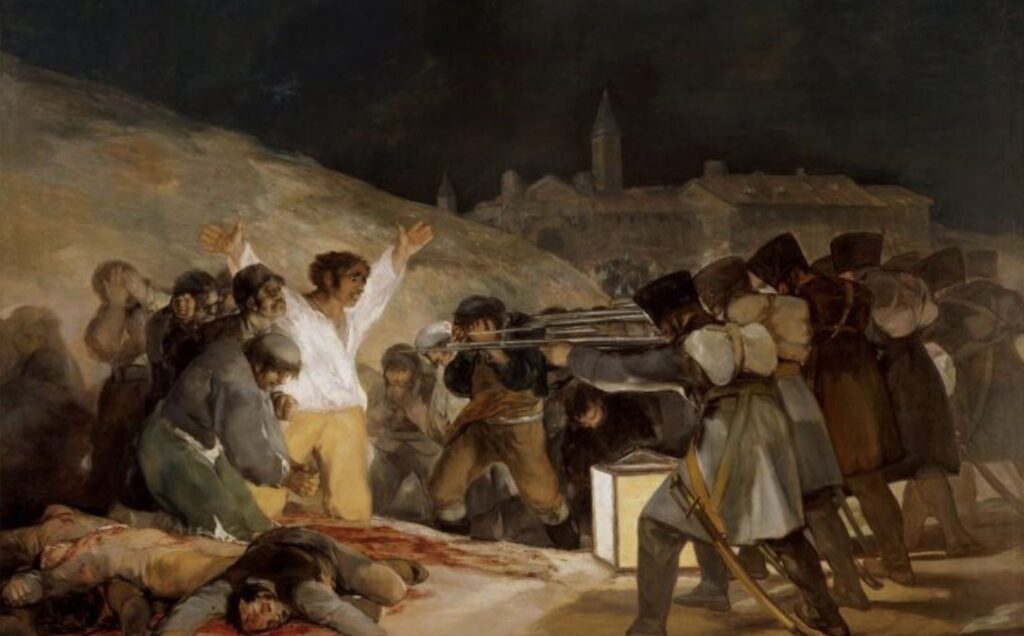
Another powerful portrayal of the Peninsular War’s brutality, highlighting the French reprisals against Spanish resistance.
The Colossus (1808-1812)
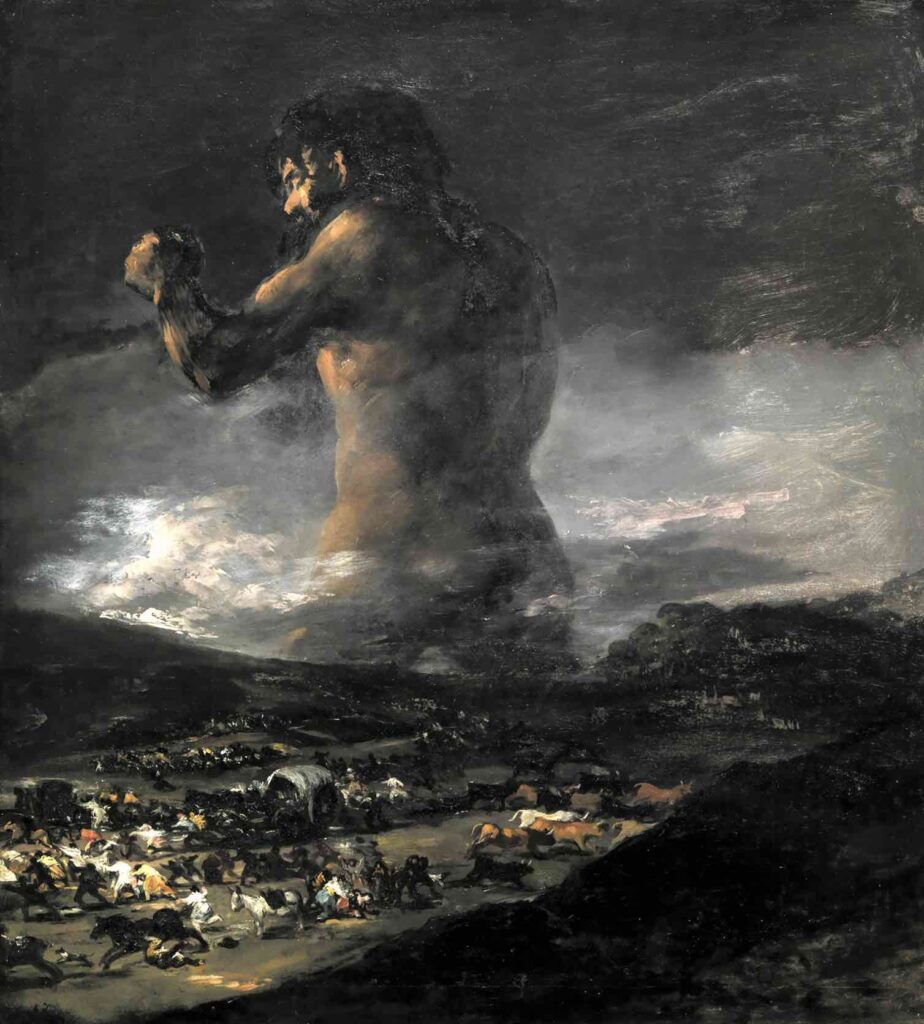
A symbolic representation of the Spanish people’s resilience during the Napoleonic invasions.
The Inquisition Tribunal (1812-1819)
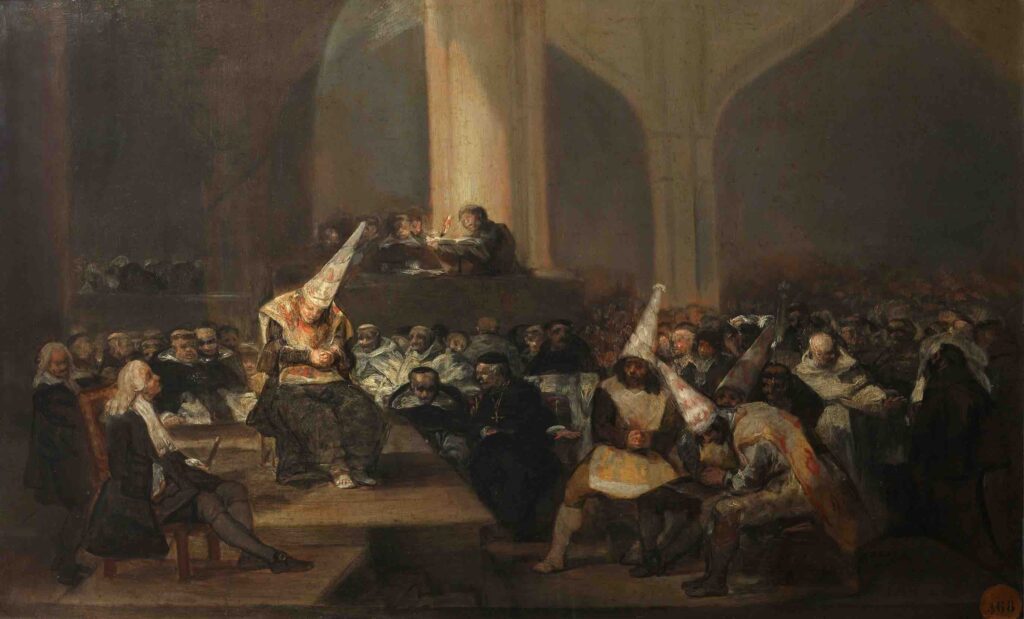
Critiquing the dogma and tyranny of the Spanish Inquisition, this artwork is an aside reflection on oppression.
Self-portrait in the Workshop (1790-1795)
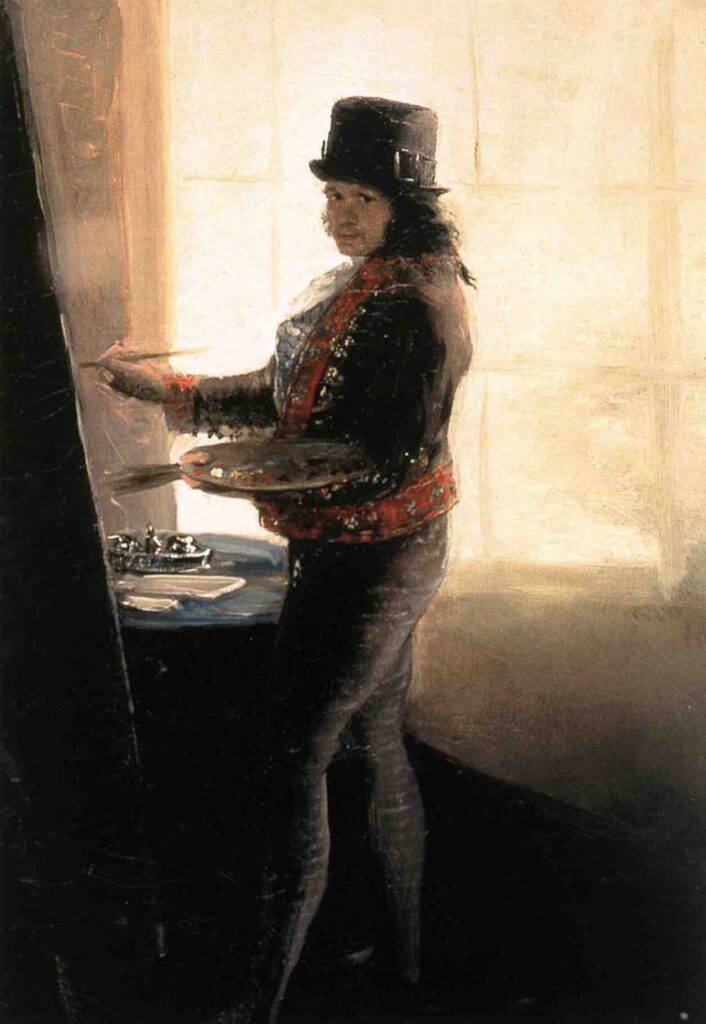
A rare glimpse into Goya’s personal life, this self-portrait encapsulates the artist in his most authentic environment.
Each of these paintings, in its unique way, sheds light on the genius of Francisco Goya. He wasn’t just an artist; he was a commentator, a critic, and a mirror reflecting the soul of an era. Through his brushstrokes, we gain insights into not just the aesthetics of his time but the very fabric of society and the human psyche.
Francisco Goya: Spain’s Artistic Visionary
Francisco Goya, often called Goya, is one of the most influential figures in Spanish art history and a significant personality in Western art.
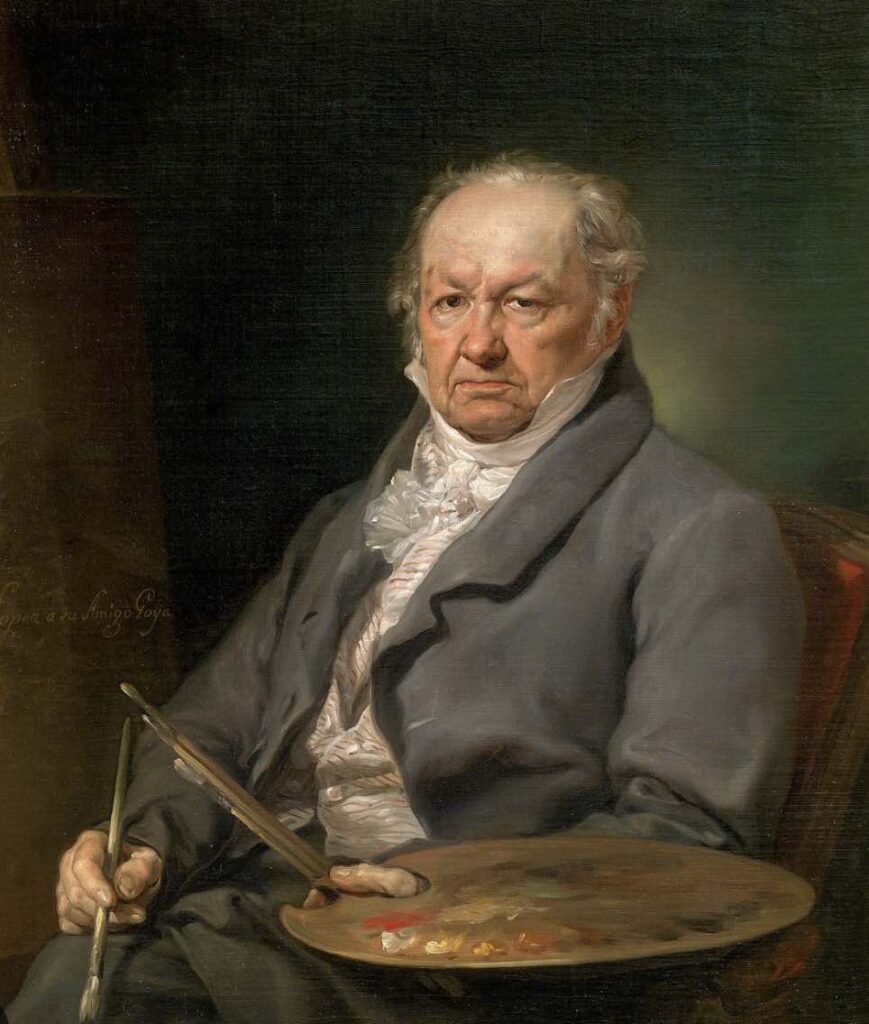
His full name, Francisco José de Goya y Lucientes, reflects his deep Spanish roots, and his art often delves deep into Spain’s tumultuous history, societal nuances, and rich cultural tapestry.
Life And Times Of Francisco Goya
Born on March 30, 1746, in the village of Fuendetodos in Aragon, Spain, Goya’s early life was relatively modest. He later moved to Zaragoza and then to Madrid to study and grow as an artist.
Goya lived during political upheaval and social change, with Spain navigating through invasions, wars, and shifting political alliances. These circumstances profoundly influenced Goya’s oeuvre.
Artistic Evolution Of Francisco Goya
Goya’s career can be broadly segmented into distinct phases:
- Early Works: Initially, he painted in a Rococo style, characterized by light themes and playful tones, often crafting tapestry cartoons for the Spanish monarchy.
- Middle Period: His works started reflecting more profound societal commentary as he evolved. This is evident in series like “Los Caprichos,” a set of etchings that satirized Spanish society, critiquing everything from the church to prevalent superstitions.
- Dark Period: Goya’s later years were marked by darker, more introspective works. His “Black Paintings” are particularly noteworthy, presenting somber themes and, often, unsettling imagery. These were painted directly onto the walls of his home and later transferred to canvas.
Significance Of Francisco Goya
What makes Goya exceptionally notable is his fearless confrontation of societal issues and his uncanny ability to capture raw human emotion. His depictions of war, especially artworks like “The Third of May 1808,” are poignant testimonies to the horrors of conflict and man’s inhumanity to man.
Goya also held significant positions, serving as a court painter to the Spanish Crown and producing numerous portraits of the Spanish aristocracy. His ability to capture the personality and essence of his subjects, often with unflattering realism, showcases his commitment to truth in art.
Legacy Of Francisco Goya
Goya’s influence extends far beyond his lifetime. Many 19th and 20th-century artists, from Édouard Manet to Pablo Picasso, have drawn inspiration from his works. Often called both the last of the Old Masters and the first of the Moderns,
Goya’s legacy bridges traditional and contemporary art, making him a timeless figure in artistic expression.
Francisco Goya is not just a Spanish treasure but a universal icon in art. He presents a vivid panorama of an era, its challenges, and its people through his paintings, etchings, and drawings.
Anita Louise Art is dedicated to art education, great artists, and inspiring others to find and create their art. We love art that uplifts and inspires. #ArtToMakeYouSmile! #ArtToMakeYouHappy!
If you want to see any of my art, you can find out more by clicking here. If you are interested in what inspires me and my paintings, you can discover more by clicking here.
We have a free newsletter and would love you to be part of our community; you can subscribe to the newsletter by clicking here. I would be happy to talk to you if you have any questions. You can reach me, Anita, by clicking here.
Subscribe to our Anita Louise Art YouTube Channel with great videos and information by clicking here.
Join us for our podcast “5 Minutes With Art.” Spend 5 minutes a week with us to discover and learn about great art and artists. You can find out more about our podcast by clicking here.
Frequently Asked Questions
What makes Francisco Goya a significant figure in art history?
Francisco Goya is considered a pivotal figure in art history for his role as a bridge between the Old Masters and modern art. His technical skill, coupled with his ability to capture the emotional and political zeitgeist of his time, sets him apart as one of the greatest artists ever.
How many masterpieces are covered in the exhibition “Francisco Goya: A Journey Through His 15 Masterpieces”?
The exhibition features 15 of Goya’s most defining masterpieces that provide a comprehensive overview of his artistic prowess and thematic range.
What themes are explored in Goya’s masterpieces?
Goya’s art delves into a wide range of themes, including the turbulent political landscape of his time, human emotions, and the spectrum of human experience. His works reflect both delight and dread, offering a rich exploration of the human condition.
Why is Goya considered a master of capturing political upheavals in his art?
Goya lived during a period of intense political turmoil, including the Peninsular War and the Napoleonic invasion. His works often serve as a visual commentary on these events, showcasing his keen observation and commentary on the political climate.
What sets Goya’s technical finesse apart in his art?
Goya’s technical finesse is characterized by his mastery of various artistic techniques, including painting, etching, and printmaking. His ability to experiment with different mediums and styles showcases his versatility and innovation.
How did Goya capture a wide range of human emotions in his art?
Goya’s keen insight into the human psyche allowed him to depict a broad spectrum of emotions in his art. From joy and celebration to fear and despair, his works provide a nuanced exploration of the complexity of human feelings.
What is the significance of Goya’s role as a precursor to modern art?
Goya’s willingness to break from traditional artistic norms and explore new themes and techniques positions him as a precursor to modern art. His innovative approach laid the groundwork for subsequent generations of artists.
Are there recurring motifs or symbols in Goya’s masterpieces?
Yes, Goya often incorporated recurring motifs and symbols in his art, such as the use of animals to represent human behavior or the presence of fantastical elements. These symbols add layers of meaning to his works.
How did Goya’s personal experiences influence his art?
Goya’s personal experiences, including his illness and deafness, had a profound impact on his art. These challenges influenced the themes and tones of his works, providing a glimpse into his own struggles and resilience.
Related Questions
What Type Of Artist Is Andy Warhol?
Andy Warhol is a Pop Artist, one of the Pop Art Movement’s major figures. Andy Warhol’s artwork explored the relationship between what is known as the mass popular cultures of his day and art. He used many iconic American objects in his art and painted many celebrities.
By clicking here, you can learn more by reading What Type Of Artist Is Andy Warhol?
Why Did New Art Movements Develop In The Years Following World War 1?
Many art movements after World War 1 came about as a direct protest about the devastation and loss of human life in the First World War. Many of these art movements also included cultural and political movements where like-minded artists band together to produce satirical and other art.
You can discover more by reading Why Did New Art Movements Develop In The Years Following World War 1? by clicking here.
Can Anyone Be An Abstract Artist Without Any Talent In Painting?
To be a great abstract artist, you need talent and an understanding of painting. Painting can be a technical skill artists spend a lifetime perfecting through art education and practice. Great abstract artists have had intensive training in painting, drawing, composition, and color theory.
You can learn more by reading Can Anyone Be An Abstract Artist Without Any Talent In Painting? by clicking here.

